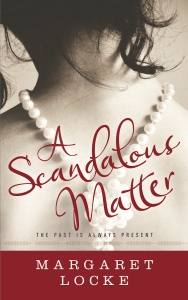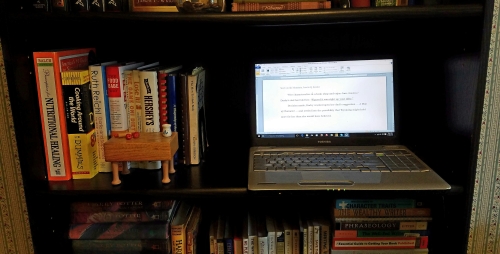Some members of the Shenandoah Valley Writers and I recently held a Twisted Baby Shower for a fellow writer. Naturally, we can’t put on a normal party — even a baby shower. Two years ago, we came to a shower dressed as our favorite authors (and literary characters) and last Sunday, we gathered to give our favorite fairy tales some decidedly deadly twists.

My writer friends and I (at left) were forced to destroy the Hansel cake, when no one was willing to take home the leftovers.
The theme was fractured fairy tales, and in addition to a game of Legos inspired by “The Three Little Pigs,” and food like grey gruel (guacamole) and a multi-flavored cake decorated to look like Hansel (from “Hansel and Gretel”), we also wrote our own twists on fairy tales that, I hope, would have made the Brothers Grimm, Jacob and Wilhelm, proud.
So, I thought I’d share with you the short fractured tale I wrote for the party, based on one of my favorites — Rapunzel.
The Breadcrumbs and the Tower
I remember the day I was taken.
Mommy had warned of talking with strangers, but Miss Abigail wasn’t a stranger. She lived next door. And anyway, I wasn’t talking with her — just waving at where she stood behind some curtains in her spooky, rundown house. Later, when I followed those breadcrumbs into the forest, I didn’t know she had put them there for me. I was only six, and I thought I was following my brother and sister. They were eight-year-olds then, and they did everything together. I just wanted to be included. I wanted a friend. It wasn’t my fault.
The breadcrumbs seemed to go on forever before finally leading me to a lone tower in a small clearing. The top was so high above me I couldn’t see where it ended, but there was a ladder on the side. I didn’t want to climb it, but a voice from up there called my name, and I was too curious not to wonder what might be inside. Daddy always said I was a dreamer — that I believed things too easily. But I didn’t know this would be a bad idea.
Twenty, thirty, forty I counted as I climbed. My legs begged me to stop, while my pounding heart urged me on, ever closer, until, gasping for air, I pulled myself in through a window.
Daylight still shone outside, but it was dark inside, and my eyes couldn’t explain to me what this room above the trees was. It was small and round with a floor that circled the sides around a small hole in the center that reached down into a pit of blackness. Then before I could decide to stay or leave — the witch, Miss Abigail, grabbed me.
It really was as quick as that, and as the weeks and months passed, and I thought back over that moment again and again wondering what I should have done differently, all I could tell myself was it wasn’t my fault. I was a little kid who had followed some breadcrumbs. It could have happened to anyone. But it didn’t happen to anyone. It happened to me. And now, here I was, the little blond girl trapped in a tower with no one but a beautiful wicked witch for company.
When she visited, she tried to be nice to me, probably so I wouldn’t try to escape. She would open the tower window’s metal doors with a screech of rusted hinges and let the sun into the cold, dank room. She brought leaves and moss for my bed and berries from the forest for me to eat. Sometimes she brought bread or sweets from towns too far for me to see, even over the trees, and she told me stories from her travels. She let me sit on her lap and play with her lovely dark hair, and I wished it were mine.
She was scary for keeping me locked in there, but she was all I had, and I even started to look forward to her visits. Because when she left me alone in the dark, closing those big metal doors with a clang, I wanted to die.
Years passed, until my strings of golden hair grew so long it dragged a few inches along the floor behind me. I was too big for such a small tower room now, and during Mother Abigail’s long absences, I would sneak outside using a key I had stolen from her one time, and lie in the moonlight or cool myself in a nearby stream.
I kept outgrowing my clothes and Mother would get angry knowing I would need something new. But she always returned with what I needed — dresses or shoes or blankets. My tower now had books so I wouldn’t be bored, and in the summer there were flowers to make the stale air smell better.
But I never saw another person until the day the boy showed up —springing a hunter’s trap as I was picking some wild mushrooms. His scream sliced through the otherwise quiet morning, and after getting over my initial shock, I decided I should help him.
Through the lush green forest I ran, until I found the boy where he was hanging upside down by one sneaker-clad foot from a rope strung over a tree branch. I wasn’t sure what kind of trap this was but guessed it was meant for animals and not children.
“Hang on,” I told him, stuffing mushrooms in my dress pockets.
“Take your time,” he said. “I’ve been hoping for a chance to find out how much blood my head can hold.”
I untied the knot in the rope that held him, not at all upset when he fell and landed on his head. But I still asked if he was okay, and after saying he was, he thanked me for saving him.
I guessed he was about my age, but I wasn’t sure exactly what age that was — maybe 12 or 13. I hadn’t seen anyone that age since the girl who played with me one time while her dad talked with my parents about some medicine they thought might stop the dreams I was having. Dreams that seemed to scare them more than they scared me.
But this boy wasn’t a dream. He was here, standing in front of me in the middle of the forest that for six or seven years had been all mine.
He was about my height, with light brown, combed hair and bright blue eyes. He carried a nice backpack and wore a sweater and corduroy pants, as if he had been on his way to school. His eyes took in my aging, tattered clothes.
“You live around here?” he asked.
“I, uh…” His question had snapped me out of my memories, and now I thought of Mother Abigail. “I got to go.” I turned and ran, ignoring his calls from behind that grew quieter the closer I got to my tower. There was no telling what Mother would do if she found me gone, and I couldn’t risk it.
My feet pounded back up the ladder steps, not pausing until I had reached the top. Then, turning, I scanned the forest floor. There was no sign of the boy, and I sucked in a relieved breath before climbing inside, and closing the doors behind me.
It was a week before I saw the boy again. I had been avoiding leaving the tower in case he was lurking around, but I’d already gone through all the food Mother had brought and, let’s face it, I was lonely. I kind of wanted to see him again.
We began arranging our meetings in the forest, on his way to or from school, and I learned his name was Peter.
“I’m Rapunzel,” I told him.
“You’re kidding,” he said. “Like the fairy tale?”
“It’s what Mother calls me.” I told him about the breadcrumbs and the tower.
“Why don’t you just leave?” he asked.
“I don’t know how to get home.”
“I’ll help you,” he said, but I was starting to get anxious now at the idea.
“She knows where my parents live — she has a house next door. She’ll find me again.”
“We’ll tell the police,” he said. “I’m sure they’ve been looking for you all these years.”
“I don’t know…”
“You can’t seriously go back to that tower.”
“I have to…” And, with that, I was away and running. But, a few minutes later, as I reached the top of the ladder, he was already climbing up after me.
I stepped into the room, searching around wildly, as if I might find a place to hide from him. And then I saw her. Mother. She had returned while I was gone.
“Rapunzel…” Peter’s voice said as he reached the top. “You know, I think this used to be a water tower.”
But as his sneakers touched the slick metal floor, Mother flew at him. She wacked him on the head with a frying pan, and he crumpled to the floor, dazed.
Mother tore up pieces of cloth from my old clothing to use around Peter’s wrists and ankles. He was writhing in pain too much to fight back.
“Rapunzel,” he said, coughing through his tears. “No.”
But Mother only cackled at his poor attempt at pleading.
“Who is this boy, Rapunzel? How’d he get here?
“I met him in the forest.”
“You dare leave this tower!”
“I heard him screaming — he was stuck in a trap. I cut him down.”
“One of my traps?”
“Who are you talking to?” Peter said, his eyes wide with horror. “W-why are you doing this?”
“You were trying to take her away from me, weren’t you?” Mother said, rounding on him. “She’s mine! She’s never going back.”
His jaw fell open, but he seemed unable to voice the thought he was going for.
“That trap,” Mother said, her tone suddenly soft, her eyes glazing over, “was for catching food. We get so little food here.”
As if in response, my stomach gurgled.
Then, with a quick shake of her head, Mother refocused on Peter.
“Sorry it’s come to this.” Mother reached for him, and he screamed, cringing away from her.
“Rapunzel, you’re sick! You need help. Let me go. I’m your friend, I’ll help you.”
But Mother wouldn’t listen. If Peter took me home, everything would be ruined. Home meant doctors and medicine and no more fairy tales. I glanced across the room to where my old clothes lay in scraps beside a set of steak knives and a camping stove I had stolen from town sometime last year. I remembered the mushrooms in my pockets — perfect for the sauce I had in mind. A quick dash into town later today for some milk and breadcrumbs would provide the remaining ingredients.
I liked Peter, but friends had never saved me before, and they weren’t going to save me now. I stood back and let Mother take over.
Mother gripped the cold frying pan handle with both hands, raising it above her head.
“Won’t you join us for dinner?”




